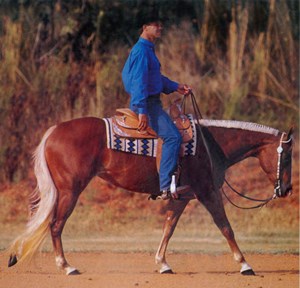When your horse moves in a balanced, collected frame, he’s propelling himself forward from his hindquarters rather than dragging himself along with his front end. Not only will this lengthen his stride, but it’ll increase his maneuverability and present a more natural, pleasing picture, in keeping with recent AQHA western pleasure judging recommendations.

My rule of thumb is that you know your horse is loping correctly when it feels as though he could change leads at any time. I’ll discuss three different levels of the lope, from a downhill, man-made looking lope to a true, balanced lope.
1. If your horse’s head is behind the vertical and her weight is shifted to the forehand, she looks as though she’s loping downhill. As a result, she’ll appear as though she’s laboring and uncomfortable. She may have an intimidated expression or pinned ears. Rather than having her feet land softly, with the same stride length between her front legs and hind ones, she’ll move unevenly and her feet will hit the ground hard. She’ll feel rough and choppy from the saddle. And, this short, choppy stride is counter to the long-strided, slow-legged movement that comes with true collection.
2. Try easing your restraint on your horse’s front-end and add a bit of impulsion. You’ll help her balance and she’ll move more naturally — and she’ll be happier. Her weight will shift back onto her hindquarters a bit more, and she’ll be better able to use her shoulders. With a bit more collection, you’ll improve her balance and athleticism.
3. Now, maintain the impulsion you’ve developed by bringing your horse’s face perpendicular to the ground. You’ll balance her body and improve her stride. Her hip will look bigger and longer (evidence she’s using it to balance her weight and power her stride.) This rearward shift will round her back, and she’ll be able to elevate her shoulders. This freedom in her shoulders will create a longer stride.
End result? A happy, relaxed horse that presents a natural, pleasing picture!
This article first appeared in the February 1999 issue of Horse & Rider magazine.






